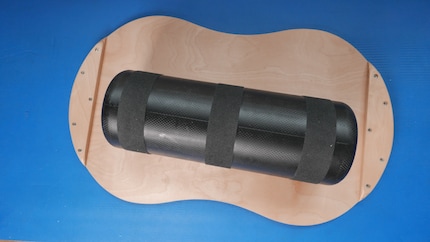

Ragettli or a sense of balance
The result of my short ski season: a bruised cruciate ligament in the family and one more RollerBone at home. A balance board, adapted for knee rehabilitation, is a fun object and a piece of fitness equipment at the same time.
There are people like me who do little coordination exercise. And there are athletes like Andri Ragettli, ace freestyle skier, to whom other laws of physics seem to apply. In his videos, we see what an athletic person gifted in coordination looks like.
Torn cruciate ligament, damaged self-esteem
On a course like this, I'd break every bone in my body. Just looking at it hurts my sporting ego. Fortunately, at the ripe old age of thirty, my body is in pretty good shape. It wasn't me who tore my cruciate ligament, but my wife. Since then, we've acquired a RollerBone 1.0 Pro board - designed to stabilise a knee that has become unstable - with which I get a certain amount of pleasure playing Ragettli.

With a non-slip surface similar to a crème brûlée - or at least a skate board - the RollerBone 1.0 features a good grip and additional flexibility of up to 100kg thanks to a narrow ridge in the centre section, enough to reassure future Ragettlis.

The "Pro" designation of this RollerBone 1.0 comes from the 3M non-slip coated roller and a slightly larger diameter than the Classic model with a softer-touch surface. The rigidity of the "Pro" roller accelerates movements and requires more balance.
According to the description, the pro roller also helps to soften the fascias. Ultimately, a fascia roller is nothing more than a slightly softer rolling pin, according to one physiotherapist asked about it. Compared to my foam roller for trigger points - understanding muscle fibre nodes - the 'Pro' offers the same sensations as a rolling pin. But the latter is placed underneath the board, which is much better.

Let's roll!
It takes a few weeks before you can tame the board on a "Pro" roller. Ok, that's not quite the truth. Just getting on it is a big challenge. A little help at the beginning doesn't hurt. Once you get the hang of it, it's surprisingly easy to find and maintain balance. That's where it gets fun, playing with weight transfer and trying extra moves, such as squats a half-turn to keep your balance in the lunge position.
You can combine a RollerBone session with other exercises, juggling on it, doing push-ups or using dumbbells. There are various ways of increasing the difficulty. You can stabilise your knees and the rest of your body while strengthening your supporting muscles. Are these exercises more like rehabilitation than a game? If so, there's another solution: skaters can try their hand at figures such as the ollie, the FS 180 and many others. What about surfers? To the hang ten, which involves having all ten toes at the end of the board. It's up to you to show your creativity and agility!

If you don't want to damage your living room floor with the RollerBone 1.0 Pro, use a floor protector RollerBone or any other gym mat! About the roller: if you've had enough, swap it for a SoftPad with which you can work on your balance and create new stimuli. In both cases, we recommend training with a balance board, even without a cruciate ligament tear.
Simple writer and dad of two who likes to be on the move, wading through everyday family life. Juggling several balls, I'll occasionally drop one. It could be a ball, or a remark. Or both.


